
The plastic to fuel machine utilizes cutting-edge technologies to convert waste plastics into valuable fuel. Beston Group provides both catalytic pyrolysis technology for cleaner oil output and continuous pyrolysis systems for stable, long-duration operation. Our solutions help customerss reduce environmental impact while improving processing efficiency worldwide. All in all, plastic into fuel machinee is ideal for sustainable waste management and commercial fuel production.
Plastic to Fuel Machine: 200% Efficiency with Catalysis System
Traditional plastic pyrolysis plant faces a technical obstacle – wax oil condensation causing pipe blockage. In Beston plastic to fuel machine, catalytic pyrolysis technology solves this problem. When pyrolysis oil gas passes through the catalytic tower, the catalyst quickly decomposes the wax molecules to prevent blockage. This catalytic action not only eliminates operational bottlenecks, but also increases the efficiency of the pyrolysis reaction by 200%. The adoption of this technology brings three core values:
ISCC-Grade Fuel Output
The catalytic upgrade allows plastic into fuel machine to produce cleaner, more refined oil that meets ISCC (International Sustainability and Carbon Certification) standards. This brings multiple downstream benefits:
- Access to premium markets: ISCC-grade oil is recognized in regulated fuel sectors across Europe and other regions, enabling higher-value sales.
- Support for sustainability claims: Certified output strengthens the end-user’s carbon reduction narrative and ESG reporting.
- Facilitates carbon credit participation: With verified traceability and sustainability, producers are eligible for carbon markets and subsidies.
- Improved fuel properties: The catalytic process reduces impurities, increasing combustion efficiency and storage stability.
Say Goodbye to Frequent Maintenance
Traditional systems often suffer from wax oil condensation, leading to clogged pipelines and forced downtime. The catalytic tower solves this by breaking down high-molecular compounds before they settle. The impact is immediate and long-term:
- Fewer shutdowns: Continuous operation becomes possible for longer stretches, improving throughput and cost-efficiency.
- Lower labor intensity: No need for frequent manual cleaning or mechanical disassembly, reducing operational workload.
- Equipment protection: Stable internal conditions prevent thermal stress, prolonging the lifespan of key components like reactors and condensers.
- More predictable output: With fewer interruptions, fuel production becomes stable, improving delivery timelines and customer satisfaction.

Technological Breakthrough of BLL-30 Continuous Plastic into Fuel Machine
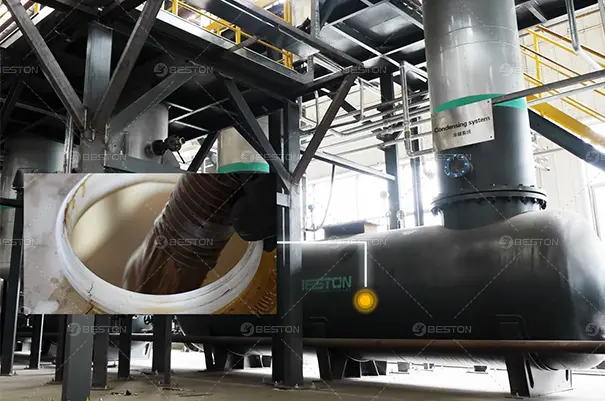
Anti-Polymerization Condensation Technology
This system uses oil-gas spray mixing to quickly reduce the temperature of oil vapor. It increases condensation efficiency and prevents olefins from polymerizing in pipelines. As a result, the plastic to fuel machine can run continuously for 30 days without shutdown.
It is a critical upgrade for any plastic to fuel machine aiming for stable, long-term performance.
- Stable operation: Continuous 30-day runtime with no need for shutdown or cleaning.
- Lower maintenance costs: Prevents clogging and reduces the need for pipe cleaning and part replacement.
- Extended equipment lifespan: Clean pipelines reduce system wear and tear.
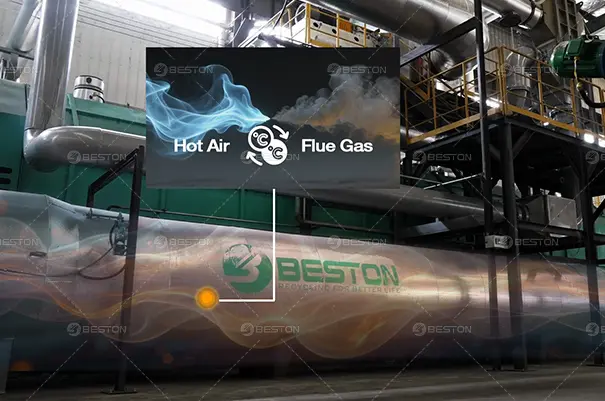
Hot Flue Gas Recycling & Air Preheating
A high-temperature stainless steel fan draws 80% of furnace flue gas back to the combustion chamber. It mixes with 1000–1300°C hot air from the burner and heats the reactor.
The remaining 20% of flue gas preheats fresh combustion air through a heat recovery unit. These two steps cut energy use by 55% and reduce exhaust emissions by 50%.
- Fuel savings: Up to 55% less fuel consumption, lowering operational costs.
- Environmental compliance: 50% fewer emissions make the system easier to meet EU standards.
- High thermal efficiency: Maximized heat utilization improves pyrolysis speed and stability.
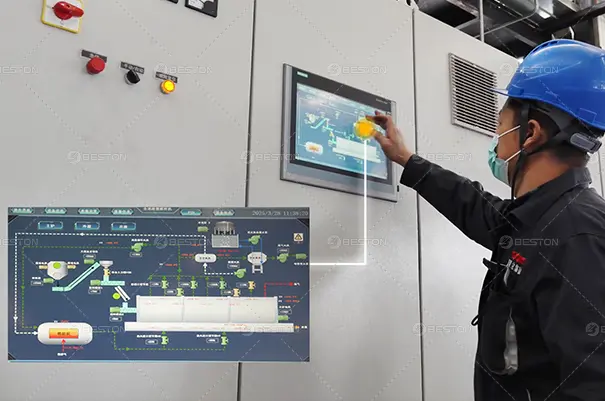
Automatic Furnace Temperature Control
The furnace uses a multi-media combustion valve set combined with hot air recycling to automatically adjust to different fuels. It controls temperature with ±10°C accuracy under varying conditions. This function ensures precise thermal regulation for plastic to oil machine operating under fluctuating feedstock quality.
- Precise control: Accurate to ±10°C, ensuring stable operating conditions and consistent product quality.
- High automation: One-touch operation without frequent manual adjustments.
- Labor savings: Only 2 operators are needed, reducing reliance on skilled labor.
Choose the Right Model of Plastic to Fuel Machine for Sale
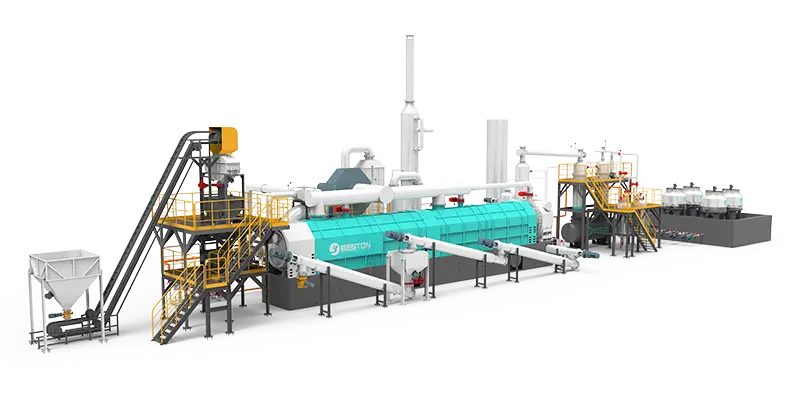
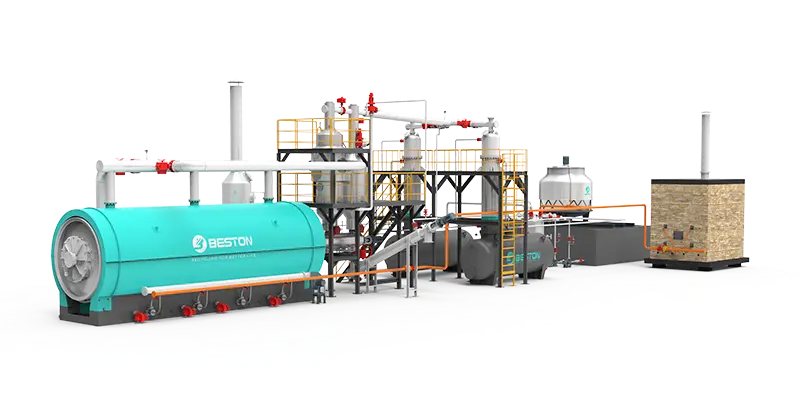
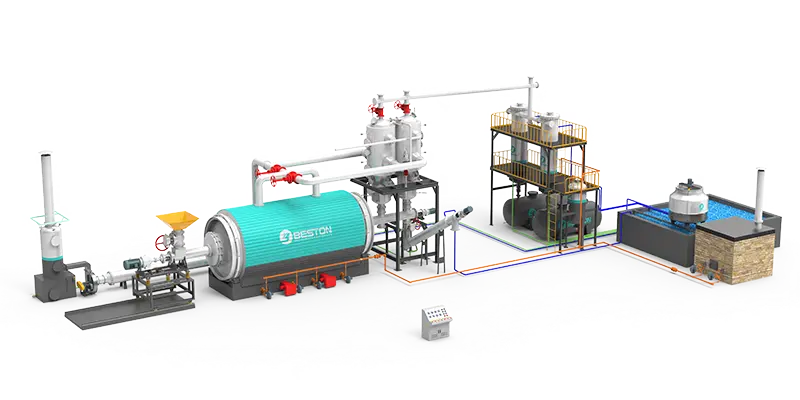

Continuous Type: BLL-30
- Process 6,000 tons waste plastic annually
- 30 day continuous operation
- High automation: two operators required
- Policy support and incentives
- Easy to get environmental compliance and approval

Batch Type: BLJ-20
- Process 4,000 tons waste plastic annually
- Get naphtha & non-standard diesel in one step
- 1 batch/day

Batch Type: BLJ-16
- Process 3,000 tons waste plastic annually
- 1 batch/day
- 3 Configuration options
| Model | BLL-30 | BLJ-20 | BLJ-16 WAX | BLJ-16 CAT | BLJ-16 Standard | BLJ-16 ULTRA |
| Manufacturer | BESTON | BESTON | BESTON | BESTON | BESTON | BESTON |
| Time to Market | 2025 | 2025 | 2022 | 2022 | 2013 | 2022 |
| Motor Brand | Chinese brand | Chinese brand | Chinese brand | Chinese brand | Chinese brand | ABB Explosion-proof |
| Suitable Raw Materials | Waste plastics; Tires; Oil sludge | Waste plastics; Tires; Oil sludge | Waste plastic bales (Max.0.9*0.9*1.6m) | Waste plastic bales (Max.0.9*0.9*1.6m) | Whole tire<120cm; Tire blocks<15cm; Oil soil with liquid content<30% | Waste plastics; Tires; Oil sludge |
| Input Capacity (Max.) | Waste plastic pellets: 0.8-1.05t/h Rubber powder: 1.25-1.5t/h Oil sludge:1.8-2.3t/h | Waste plastic pellets: 12-13t/d Tire: 18-20t/d Oil sludge:20-25t/d | 8-10t/batch | 8-10t/batch | Whole tire <120cm or Tire blocks<15cm: 10-12t/batch Sidewall removed tire: 15-16t/batch Oil soil: 16-18t/batch | Waste plastic bales: 8-10t/batch Whole tire <120cm or Tire blocks<15cm: 10-12t/batch Sidewall removed tire: 15-16t/batch Oil sludge: 16-18t/batch |
| Working Method | Fully Continuous | Batch | Batch | Batch | Batch | Batch |
| Final Oil Quality | Pyrolysis oil Pyrolysis oil with wax or naphtha | Pyrolysis oil, Non-standard diesel and naphtha | Pyrolysis oil with wax | Pyrolysis oil with naphtha | Pyrolysis oil | Pyrolysis oil Pyrolysis oil with wax or naphtha |
| Reactor Material | 304/310S Stainless steel | Q345R Boiler steel and 304/316L/310S Stainless steel | 304 Stainless steel | 304 Stainless steel | Q345R Boiler steel | 304 Stainless steel |
| Reactor Life Span (Years) | 5-8 | Q345R Boiler steel 2-3 304/316L Stainless steel 5-8 310S Stainless steel 8-10 | 5-8 | 5-8 | 2-3 | 5-8 |
| Guarantee (Months) | 12 | 12 | 12 | 12 | 12 | 12 |
| Delivery Time (Calendar Days) | 60-90 | 60 | 60 | 60 | 45 | 90 |
| Land Space Required (L*W*H*m) | 70*20*10 | 40*13*8 | 33*13*8 | 33*13*8 | 33*13*8 | 33*26*8 |
| Packing | 20*6*3m in bulk+13*40HQ | 1*40FR+4*40HQ | 1*40FR+3*40HQ | 1*40FR+3*40HQ+1*20GP | 1*40FR+3*40HQ | 1*40FR+8*40HQ |
| Installation Period (Calendar Days) | 60-90 | 45 | 45 | 45 | 45 | 60 |
Why Turn Plastic into Fuel?
Non-biodegradable to Renewable
Most post-consumer plastic waste cannot be degraded even after hundreds or thousands of years. The stable polymer structure of plastics can resist degradation by microorganisms and enzymes. Therefore, converting plastic into fuel can achieve the transformation of waste resources into renewable resources. This not only reduces the burden of natural degradation of plastics, but also provides a new source for the demand for alternative fuels.
Reduce Ecological pollution
Plastics in daily life endanger the survival, reproduction and environment of organisms. After plastic waste enters the natural environment, it has a long-term negative impact on organisms and may even cause the death of organisms. In addition, the harmful chemicals contained in plastics can pollute soil and water bodies, further threatening the ecosystem and human health. Converting plastics into fuel can effectively reduce the pollution of plastics to the environment.
Avoid Resource Waste
More than 10% of global oil consumption is used for plastic production. However, only 10% of waste plastics can be effectively recycled. Most of the remaining plastic waste is landfilled or incinerated, which causes an extreme waste of fossil resources. Through the resource cycle model of “fossil fuel-plastic-renewable fuel”, recyclers can make full use of the energy value in waste plastics.Thus, this maximizes the utilization rate of waste resources

Which Types of Plastic are Suitable for Plastic to Fuel Machine?
There are many types of plastics. According to their composition, plastics are mainly divided into PET, HDPE, PVC, LDPE, PP, PS, PU, PE, etc. Among these types, the following plastics can be processed into plastic oil by plastic into fuel machine:

PET
- Oil Yield: 0%;
- Sources: transparent bottles, mechanical parts, fiber products, etc.
- Feature: The oxygen produced by the reaction poses a safety hazard.

HDPE
- Oil Yield: 85%~95%;
- Sources:daily necessities containers, pipe fittings, household items,etc.
- Feature: high tensile strength, corrosion resistance.

PVC
- Oil Yield: unstable;
- Sources: wire insulation, municipal pipes, outdoor building materials, etc.
- Feature: oil obtained from PVC contains chlorine. Burning oil produces dioxins.

LDPE
- Oil Yield: 85%~95%;
- Sources:packaging films, bags, disposable tableware, etc.
- Feature: low strength, good flexibility, easy collection

PP
- Oil Yield: 80%~90%;
- Sources:food packaging, medical supplies, household products, etc.
- Features: good heat resistance, chemical corrosion resistance.

PS
- Oil Yield: 80%~90%;
- Sources: disposable tableware, lightweight casings, crafts, etc.
- Features: Good formability, meets food grade certification standards.

ABS
- Oil Yield: 40%;
- Sources: Electrical appliance shell, daily necessities, advanced toys, etc.
- Features: good mechanical properties, easy to paint and print.
How to Convert Waste Plastic to Fuel?
In this pyrolysis process, the waste plastics are converted into fuel. Here are the steps involved in converting plastic to fuel:
Sorting and Pre-treatment
The first step is to sort the plastic waste by type and remove any non-plastic materials. The plastic is then shredded into small pieces to facilitate pyrolysis.
01
Heating
02
Pyrolysis Oil & Syngas Formation
- Pyrolysis Oil: High-temperature oil and gas enter the manifold and catalytic tower to separate heavy oil substances and wax oil impurities. The purified oil and gas enter the condenser, where the oil and gas can be condensed to form plastic pyrolysis oil.
- Syngas: The flue condenser and water seal purify the non-condensable oil gas to form syngas, which provides heat source for the pyrolysis reaction again.
03
Emission Gas Treatment
The emission gases can be treated to remove pollutants by a de-dusting system before being released into the atmosphere. The dedusting system includes condenser and atomization tower. Beston Group provides customized de-dusting system to meet the emission requirement in the local area. Send your demand to Beston Group.
04
Solid Discharging
After the volatile hydrocarbons in the plastic are completely involved in the pyrolysis reaction, solid residues are left, which are discharged through a water-cooled discharger.
05
The Plastic Oil Rate in the Pyrolysis Process
The plastic oil rate varies depending on several factors, including the type of plastic waste being processed, the quality of the waste plastic to fuel conversion plant, and the operating conditions of the machine. Generally, the plastic oil rate ranges from 20% to 90% of the total weight of the plastic waste.
The type of plastic waste being processed can have a significant impact on the plastic oil rate. Some types of plastic, such as polyethylene and polypropylene, have a higher plastic oil rate than others, such as PP and PE. This is because the molecular structure of these plastics is more conducive to the pyrolysis process.

Application Scenarios of Plastic Fuel Oil
The application scenarios of plastic pyrolysis oil are diverse and can be used in a variety of industries. By utilizing plastic fuel, we can reduce our dependence on fossil fuels and help to reduce the environmental impact of plastic waste. Some of the most common application scenarios of plastic oil include:
| Application | Practical Use |
|---|---|
| Industrial Heating | Used as fuel for industrial heating applications, such as in cement factories and boilers. |
| Power Generation | Used as fuel in diesel engines or generators to produce electricity. |
| Transportation | Blended with conventional fuels, such as gasoline or diesel, for use in vehicles and ships. |
| Chemical Production | Used as a feedstock in the production of chemicals like benzene, toluene, and xylene. |
| Lubricants | Refined to produce lubricants and other high-value products. |
| Asphalt Production | Used as a binder in the production of asphalt for road construction. |

Beston Plastic to Fuel Machine Project over the World
Beston Group is a well-known plastic to fuel machine manufacturer and has shipped its products to over 80 countries worldwide. We has built a strong reputation for producing high-quality machines that are reliable, efficient, and environmentally friendly. Beston plastic to fuel oil machines are the go-to choice for many customers because of several reasons, including their innovative technology, outstanding customer service, and competitive pyrolysis plant prices. Please see the detailed cases.
Services to Customer Beston Group Offers
-
 Pre-sales Service
Pre-sales Service- Professional plastic material testing;
- Online consultation;
- Factory visit;
-
 In-sales Service
In-sales Service- Solution adjustment;
- Design drawings;
- Real-time shipping updates;
-
 After-sales Service
After-sales Service- Installation guidance;
- Technical support;
- Product software upgrades.

Get Your Plastic to Fuel Solution
According to the United Nations, the world produces over 300 million tonnes of plastic waste every year. A significant amount ends up in landfills, oceans, and other ecosystems. This condition poses a threat to waterways, wildlife, human health, and climate change. Using plastic to fuel oil machines is a solution to the growing problem of plastic waste. Beston Group provides six models and competitive plastic to fuel machine prices. Besides, Beston Group offers flexible solutions. When customers need these plastic to fuel renewable energy services, contact Beston Group.











